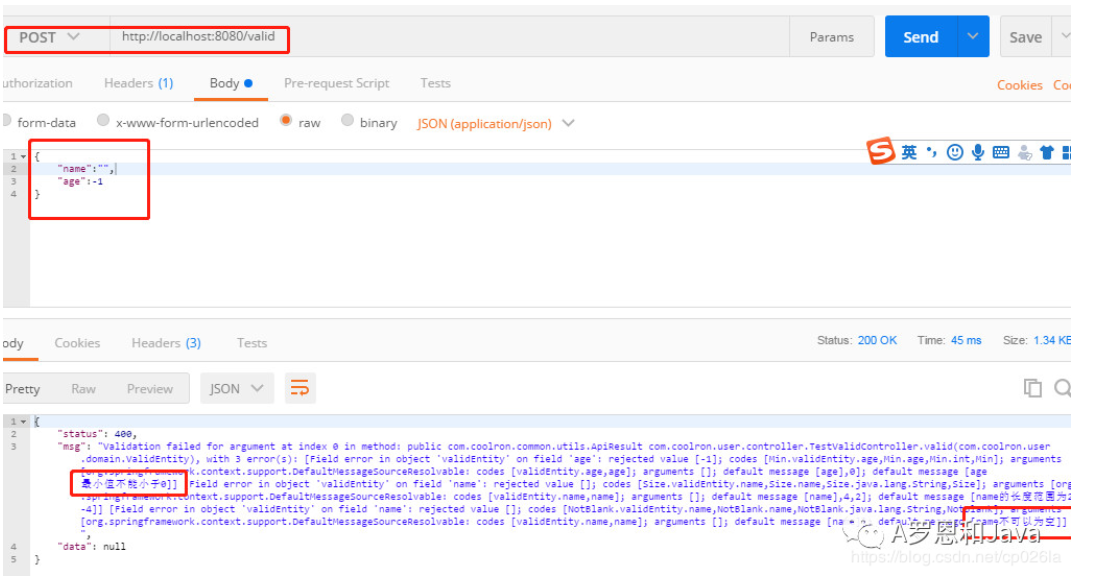Editor:
https://blog.csdn.net/cp026la/article/details/86495659
Nonsense:
The beginning of time writing code or do not do to check parameters, or write many similar if (xx == null) {...} statement, parameters always want to check to be front-end processing (very witty), end of service calibration parameters are equally important.
Check parameters:
springboot need to introduce springboot-starter-validation (verification using Hibernate Validator framework provides functionality) dependent calibration parameter, since the item has been introduced springboot-starter-web-dependent (comprising springboot-starter-validation dependent ), you do not need to repeat references.
1, the basic introduction notes:
@NotEmpty: role String, collection, map, the array is not null, the size> 0 @NotBlank: only for String, can not be null, can not be "", i.e., trim (rear) length is greater than 0 @ @NotNull: acting on any type and can not be null, can be null @AssertTrue: must be to true @AssertFalse: must to false @min (value): it must be a number that is equal to and greater than a specified value @Max (value) : must be a number, and the value of a specified value or less @Size (max, min): limiting parameter size range @Future: it must be a future date @Past: a date in the past must be @Pattern (value): Specifies regular
2, the entity class:
/ **
* @Auther: XF
* @date: 2018/11/01 23:27
* @Description:
* /
@Data
public class ValidEntity {
@NotBlank (Message = "name may not be empty")
@Size (= 2 min , max = 4, message = "name length is 2-4")
Private String name;
@NotNull (Message = "Age is not null")
@min (value = 0, Message = "Age not less than the minimum value 0 ")
Private int Age;
}
3, the test Controller:
/ **
* @Auther: XF
* @date: 2018/11/01 23:35
* @Description: check test parameters
* /
@RestController
@ SLF4J
public class TestValidController {
@PostMapping (value = "/ Valid")
public ApiResult Valid (@Valid @RequestBody validEntity validEntity) {
log.info ( "entity class information >>>>: >>>> {}", JSON.toJSONString (validEntity));
return ApiResult.ok (validEntity);
}
}
4, the test results:
here POST request, using Postman:
4.1, the correct transmission parameter (here parameter JSON format) returns the correct result.
4.2, mass participation error error response message

Error Log:

5、注意:
此处的日志很显然是统一异常处理类GlobalExceptionHandler中的日志,即参数校验不通过的时候走到了统一异常处理类中了。这里返回了所有的异常信息,显得不优雅,我们可以在统一异常处理类中断点调试得到该JSON格式错误的参数校验不通过是使用的MethodArgumentNotValidException 返回的。

6、当我将请求参数的@RequestBody 去掉后:
@PostMapping(value = "/valid")
public ApiResult valid(@Valid ValidEntity validEntity) {
log.info(">>>>实体类信息为:>>>>{}", JSON.toJSONString(validEntity));
return ApiResult.ok(validEntity);
}
再次请求:

断点调试得到的是BindException

于是,我们可以在统一异常处理类中添加这两个异常的处理方法,当然也可以在原来的Exception 处理中去做判断,这里分别添加这两个异常的处理。
7、修改原来的全局异常处理类:
@RestControllerAdvice(annotations = {RestController.class})
@Slf4j
public class GlobalExceptionHandler {
/**
* 默认统一异常处理方法
* @ExceptionHandler 注解用来配置需要拦截的异常类型, 也可以是自定义异常
*/
@ExceptionHandler(Exception.class)
// 此处可以指定返回的状态码 和 返回 结果说明
// @ResponseStatus(reason = "exception",value = HttpStatus.BAD_REQUEST)
public Object runtimeExceptionHandler(Exception e) {
// 打印异常信息到控制台
e.printStackTrace();
log.error("请求出现异常,异常信息为: {}", e.getMessage());
// 使用公共的结果类封装返回结果, 这里我指定状态码为 400
return ApiResult.build(400, e.getMessage());
}
@ExceptionHandler(MethodArgumentNotValidException.class)
public ApiResult handleBindException(MethodArgumentNotValidException ex) {
FieldError fieldError = ex.getBindingResult().getFieldError();
log.info("参数校验异常:{}({})", fieldError.getDefaultMessage(),fieldError.getField());
return ApiResult.build(400, fieldError.getDefaultMessage());
}
@ExceptionHandler(BindException.class)
public ApiResult handleBindException(BindException ex) {
FieldError fieldError = ex.getBindingResult().getFieldError();
log.info("参数校验异常:{}({})", fieldError.getDefaultMessage(),fieldError.getField());
return ApiResult.build(400, fieldError.getDefaultMessage());
}
}
至此参数校验配置完毕。